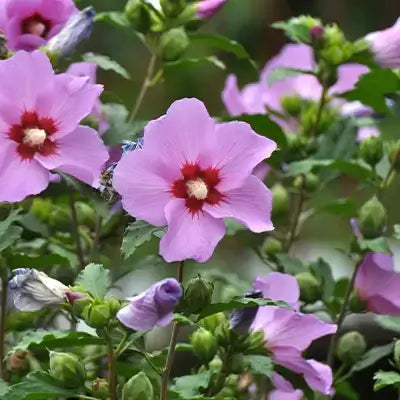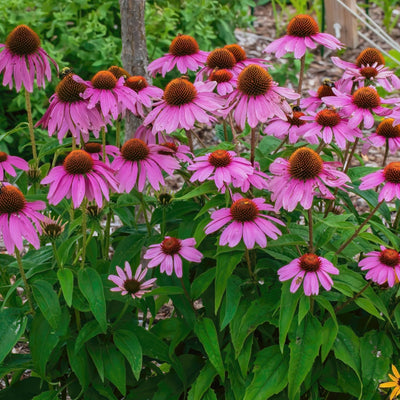The rose of Sharon shrub has been long popular among people as it could be cultivated in a large variety of conditions and the flowers of the tropical style are so plentiful. These are tough non-evergreen plants that add color to gardens during the late summer when most other plants have ceased to bloom. Rose of Sharon shrubs can dramatically transform the appearance of your yard whether you use them to build a hedge or a colorful specimen planting or fill in an area that is a good hedge to pollinators.
This paper will inform you where to find rose of sharon shrubs, what type, how to plant and maintain it to ensure your garden remains in season.
Understanding the Rose of Sharon Shrub
Rose of Sharon (Hibiscus syriacus) does well in the USDA Hardiness Zones of 5-9. It is known to have magnificent trumpet-shaped flowers, which may be their white, pink, lavender, blue or even a combination of two colors. The shrub is a blessing to surroundings and appearance since all the flowers attract butterflies and hummingbirds.
Rose of Sharon of all sorts is famous in kind, so have you Aphrodite, with her rosy-pink flower, and Blue Chiffon, with her sky-blue flower, and White Chiffon, with her bloom of exquisite white. You can easily make your surroundings appear the way you desire since every species has got its way of growing and color shade.
The Rose of Sharon has a very close variety; the Rose Mallow (Hibiscus moscheutos). It is easy to keep, and as easy to keep as the Rose of Sharon, and it gives large flowers. You should visit it if you want tropical-looking flowers.
How to Plant Rose of Sharon Shrubs
Growing Rose of Sharon shrubs does not require much effort even when one is a beginner gardener. Select an area where there is a minimum of six hours of direct sunshine per day. These bushes can grow in a great variety of soils, but best in soil of a wet and well-drained nature.
How to plant well:
- Open twice as wide and deep as the root ball.
- Plant the plant in the ground such that the top of the plant is at the same level with the ground.
- Then add fertilized earth, and water it to settle the roots.
- The layer of mulch will be 2 inches to ensure that the soil remains wet and the weeds do not grow.
In purchasing rose of sharon shrubs, always get healthy and well rooted rather than cheap shrubs that would be root-bound. TN Nursery also possesses good field-grown shrubs that will make them grow well.
In order to get a color that matches your new bush and appeals to your pollinators, plant it with Purple Coneflower, another hardy perennial that grows well with hibiscus.
Rose of Sharon Shrub Care Throughout the Seasons
Rose of sharon varieties is easy and pleasant to look after. When you take good care of your shrub in the right way throughout the year, it will also bloom very much every year.
Caring about Spring and Summer
A balanced slow-release fertilizer will be required to help the new growth get started. Deeply water it once a week. Water it frequently when it is dry. The shrub grows long and flowering and flowering normally occurs between July and September, although it requires water and sun on a daily basis.
Plants that produce blooms continuously should be pruned lightly at the beginning of the spring before they become buds. A slight reduction in size and form of the Rose of Sharon leaves it in its size and form and causes it to bloom more.
Getting Ready for Autumn
Prune off dead flowers and remove those branches that are not in the correct position when the flowers are dead. Clear up the fallen leaves so that no fungus can be created. On the bottom of the roots place compost or organic mulch to keep them warm in the winter.
Winter Care
The Rose of Sharon pruning is tough especially in handling the things during the winter. Cover the bottom stems in frosty areas with straw or leaves. A lot of pruning should not be done during the winter since it may reduce the number of flowers to bloom the following year.
By keeping the roots wet during the dry times by watering the plants frequently, the roots will not become hard.
How to care for the rose of Sharon ?
- Water the plants frequently to ensure that their roots grow deep during the initial season of growth.
- Add fertilizer to the plants every spring to enable them to produce new leaves and blossoms.
- Keep it trim by chopping off some branches that are broken or intersected.
- A flower that has its heads removed lives longer.
- Be on the lookout for aphids or whiteflies and spritz them with mild soap immediately.
With these instructions, your shrubs will remain healthy and will be grown in a proper manner every year.
To find out more tips on how to take care of plants in your location, visit reliable gardening websites such as the USDA Plant Database.
FAQs
Q1: When is the best time to plant Rose of Sharon shrubs?
Plant Rose of Sharon shrubs in the early spring after the last frost or in the fall before the first frost. This timing offers the roots time to settle down before the weather gets too hot or too cold. Don't plant in the summer because you'll need to water more.
Q2: How fast do Rose of Sharon shrubs grow?
Rose of Sharon bushes grow swiftly, usually reaching heights of 8 to 12 feet and widths of 6 to 10 feet. They bloom a lot from the middle of summer to the fall, which adds a lot of color to your garden.
Q3: How much sun does a Rose of Sharon need to bloom well?
Rose of Sharon grows best in full sun and needs at least six hours of direct sunlight per day. They can take considerable shade, although there may not be as many flowers.
Q4: Where is the best place to plant a Rose of Sharon?
Pick a place that gets a lot of sun, is protected from the wind, and has soil that is rich and drains well. Put space between shrubs that is 6 to 8 feet apart (3 to 4 feet for dwarf types) so they have enough air and room to grow.
Q5: Are there invasive concerns with Rose of Sharon?
Rose of Sharon can drop a lot of seeds on its own, which could cause it to expand too much in some areas. Choose sterile types like "Azurri Blue Satin," "Sugar Tip," or "Diana." Then, to keep the seeds from spreading, practice deadheading.



